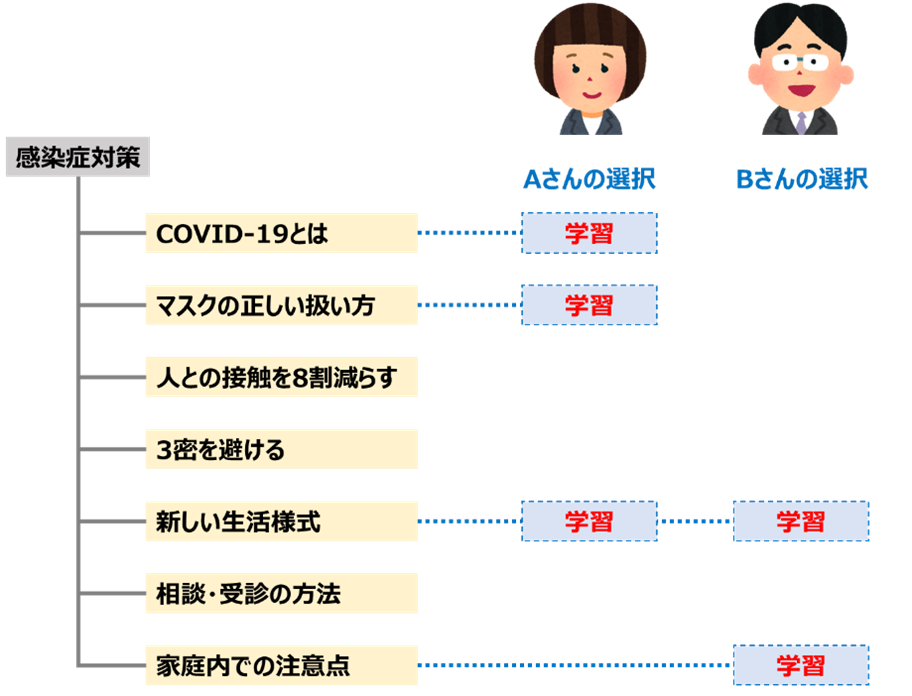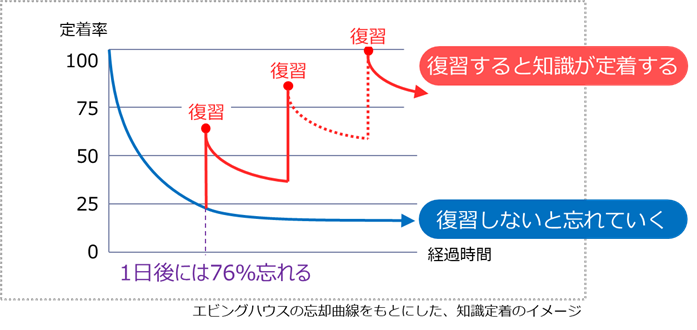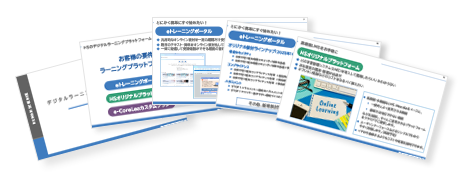2021.06.08
What is Microlearning - Advantages and Disadvantages -
The biggest feature and advantage of e-learning materials is that they can be taken regardless of time and place. On the other hand, when implemented, the following voices may be heard.
・The materials are too long (the learning time is too long)
・There is too much content to remember
・There are too many items, and just looking at the table of contents weakens the motivation to learn
The amount of study time and the volume of study materials have become points of particular concern for our clients in recent years.
Specifically, we receive requests such as, "Total study time should be within 30 minutes" and "Each unit should be completed within 3 minutes."
It is said that the maximum duration of human concentration is about 15 minutes. Additionally, by keeping learning sessions short, the content can also be narrowed down. From these points, shortening learning time is effective for reinforcing learning material and motivating learners. Furthermore, it can also reduce the development costs per educational material.
By the way, are you familiar with "microlearning"? As the name suggests, "microlearning" is a learning style that allows you to complete learning in a short amount of time, and it is gaining attention as a new trend in e-learning.
Microlearning is considered to have a volume of about 5 minutes per material, embodying the concept of "learning that can be done anytime and anywhere."
This time, we will explain the following about the learning style that can be completed in a short time, "microlearning."

1. What is Microlearning?
"Microlearning" is the name of a learning style that began to gain attention after being introduced at the ATD International Conference & EXPO (ATD ICE).
The features of microlearning are,
・Learning is completed in a short time (about 1 to 5 minutes)
.
This is an image of actual learning.
- ・Learners can freely choose materials that interest them or materials that are needed at the time.
- ・Learn only the necessary information in a short time at a convenient timing
- ・Each material is independent, and the order of learning is flexible
The provider prepares multiple teaching materials and updates or adds them as necessary. Additionally, they set up the learning environment, including managing distribution and learning history.
Learners combine the materials they need at any given time and proactively advance their learning.
Here are some specific examples.
Let's assume that multiple teaching materials are prepared on the theme of "Infectious Disease Control."

Learners can view the lineup of teaching materials and freely choose the materials they need at that time or are interested in for their studies.
Since they can be freely combined, it also has the aspect of being able to flexibly respond to differences in the knowledge required for each learner, the level of knowledge at the start of learning, or limited time available for study.
2. Benefits of Microlearning
The main benefits of microlearning are as follows.
- ・Learn during your spare time
- ・Obtain only the necessary knowledge when needed
- ・It is less likely to feel resistance to repetitive learning, making it easier for knowledge to be retained.
- ・It can also serve as motivation for practical application, leading to desired behavioral change
First, it can be completed in just a few minutes, allowing you to learn during travel time or short breaks.
Additionally, because the themes are clear, you can learn the necessary knowledge precisely.
Learners can complete their studies with the materials they have chosen while maintaining focus. Furthermore, since it can be finished in a few minutes, it is less daunting for repeated learning, making it easier to retain knowledge.
As shown in this figure, repeated learning is said to be an effective method for knowledge retention.

Furthermore, the teaching materials can serve as motivation for practical application, and as a result, we can expect behavioral changes after learning.
There are benefits for those who provide educational materials as well.
- ・The theme is clear and the content is narrowed down, making it easier to develop
- ・Due to its small volume, modifications and revisions are easy
- ・Increased likelihood of rising learning frequency and achievement rates
- ・Create an environment where learning is easy, allowing the organization to establish a culture of learning.
You can expect significant results while keeping development costs down.
3. Disadvantages of Microlearning
Microlearning has its drawbacks.
First, depending on the learning theme, there are some topics that are not suitable for microlearning. This is an important point.
Examples of themes that are considered unsuitable for microlearning.
- ・Systematic learning is required for grammar, language acquisition, and technical skills.
- ・Items that require a substantial amount of study or study time
- ・Complex things that require time to understand
- ・For the purpose of obtaining and maintaining qualifications
- ・Items that require discussion and workshops
Microlearning materials need to stand alone. Therefore, they are not suitable for a curriculum that builds from the basics to acquire advanced knowledge.
Additionally, explaining the mechanisms of complex machines or precision instruments in a short time is not realistic; rather, it may be easier to understand when explained over a longer period.
Based on the above, before starting the creation of microlearning materials, it is necessary to first analyze whether the subject matter is suitable for microlearning, as well as the learning themes and curriculum.
It is also possible to extract part of the curriculum and create microlearning materials for specific sections.
For example, let's consider the case of training in customer service.
First, the common rules and foundational knowledge that all employees share will be systematically learned through group training and standard e-learning materials.
After that, individual case studies and applied content will be prepared in multiple microlearning materials based on job type, area, and sales floor, allowing each employee to learn freely as needed.

(In this way, learning that combines multiple formats is referred to as "blended learning" or "blended learning type." )
Microlearning materials are important because they are resources that allow you to quickly learn only the "necessary knowledge."
How about considering the creation of microlearning materials that offer various benefits?
4. A platform for microlearning,Key points for choosing an LMS
A platform for managing microlearning is called an LMS (Learning Management System). To avoid the situation of it not being suitable after implementation, careful comparison and consideration in choosing the platform is important.
From here, we will explain the key points for selecting a microlearning platform.
Are there various types of learning?
Microlearning is suited for platforms that allow for a variety of learning methods, such as quizzes and videos, due to the short duration of learning time.
Is management easy?
When distributing learning content, management is necessary.
The easier the platform is to use, such as for individual progress and distribution systems, the more it can reduce effort.
Is it multilingual supported?
If foreign employees are to use microlearning, the platform must support multiple languages. Choose a platform that allows operations and message sending in multiple languages, such as English.
Is it user-friendly for learners?
To actively engage in microlearning, usability for learners is important. It is essential to incorporate the learner's perspective, such as having a clear screen and ensuring that operations are stress-free.
Pricing Plans and Usage Restrictions
The fees vary depending on various conditions such as the number of learners and the type of server.
If you use a plan that accommodates a large number of users but only have a small number of users, you will incur unnecessary costs. Additionally, the storage capacity for materials may differ depending on the pricing plan. With plans that have limited capacity, it is important to note that even if you create many image and video materials, you may not be able to distribute them. Conversely, it would be wasteful to choose a large capacity plan when you have a small number of users.
The key is to compare the number of learners, capacity, and plan details to select the appropriate platform.
Finally, here are the key points for choosing a company. As the number of companies selling LMS has been increasing, checking case studies and understanding whether they have a solid track record will make it easier to implement the platform.
5. Introducing Moodle from the platform
One of the recommended platforms is Moodle.
Moodle is an open-source software that supports multiple languages and is used globally, with over 200 million users currently using this LMS.
Open Source Software (OSS) is software whose source code is made publicly available for free, allowing anyone to modify and redistribute it. Since there are no licensing fees, it offers cost advantages and is utilized by companies with high employee turnover, such as part-time and temporary workers.
Additionally, companies can add necessary features unique to their needs, allowing for customization to make it the most user-friendly for them.
The range of files that can be uploaded is also broad, making it suitable for microlearning, where learning time is short.
Moodle has group functions, allowing the creation of groups such as this sales department for this document, or this video for new employees, enabling file sharing only with those specific employees, making it user-friendly for administrators and safe to use even in large companies with a wealth of knowledge.
Moreover, the dashboard allows for progress information to be checked at any time, and with the reporting feature, management is easier, and understanding of learning can be assessed through reports.


Please see the costs here.
> Moodle Implementation and Operation Support Service Costs
6. Leave Moodle implementation to Human Science
Our company became an official Moodle partner in 2017, certified by the Moodle headquarters in Australia. Only companies with expertise and a proven track record in Moodle development and implementation are recognized as official partners, and while there are many around the world, there are only a few in Japan, with our company being the number one in domestic achievements for schools and organizations.
As an official partner, we have access to a dedicated site where we can obtain information necessary for the implementation and operation of Moodle.
Additionally, we can raise requests to Moodle Headquarters, which allows us to influence future Moodle development.
Our company first conducts a hearing of the customer's requirements for implementation, followed by design, construction, and lectures for usage.
Furthermore, even after implementation, we provide support such as post-usage tuning and usage seminars, aiming to establish a system that can offer all the necessary services to achieve the customer's objectives.
In addition to Moodle, Human Science has an outstanding track record in achieving microlearning through e-learning and manuals. If you have any concerns regarding microlearning, please feel free to consult with Human Science.
> Moodle Implementation Support and Operation
Next time, we will focus on how to create actual microlearning materials.
"How to Create Microlearning - Human Science Methods"
Author:
Shizuko Sase
Education Solutions Department Production Group Writer
After joining Human Science, worked as a technical writer,
gaining experience in the design and writing of product manuals and business manuals.
Subsequently engaged in writing and production direction of e-learning materials.
Involved in the production of approximately 200 educational materials so far.
Contact Information:
Phone Number: 03-5321-3111
hsweb_inquiry@science.co.jp












